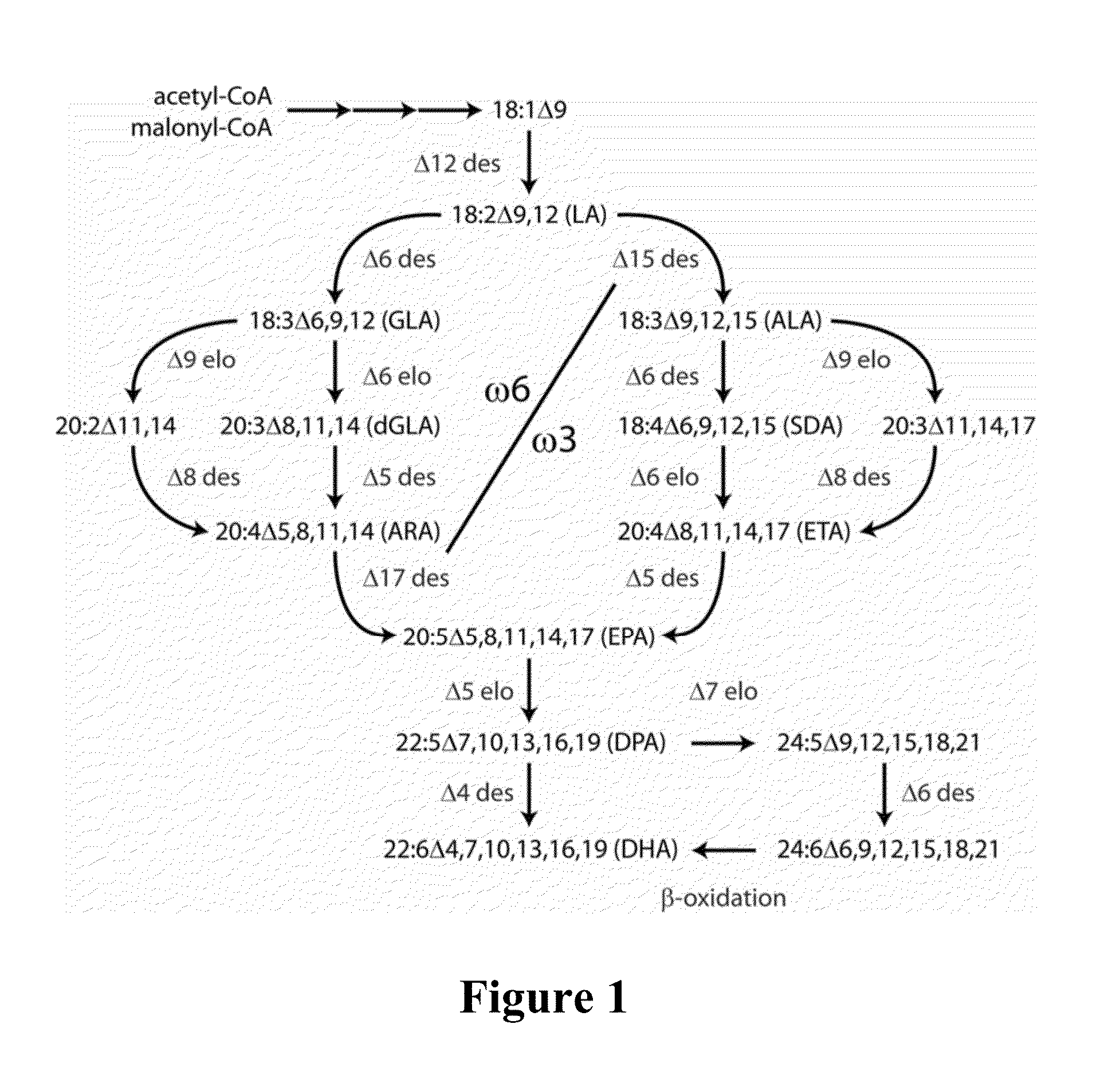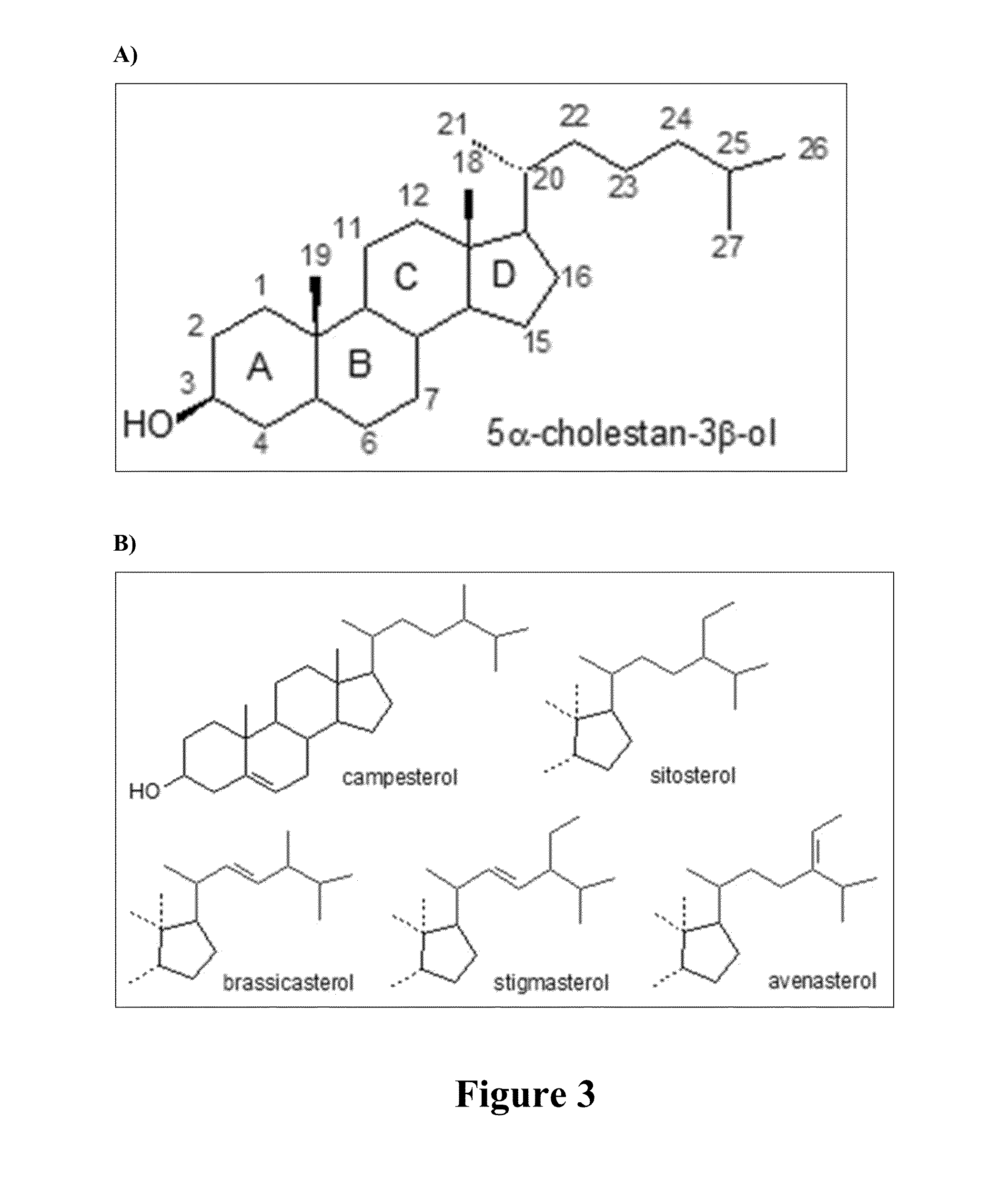Lipid comprising docosapentaenoic acid
a technology of docosapentaenoic acid and lipid, which is applied in the direction of enzymology, plant/algae/fungi/lichens, drug compositions, etc., can solve the problems of limited, if any, options, and achieve the effect of efficient production of lc-pufa
- Summary
- Abstract
- Description
- Claims
- Application Information
AI Technical Summary
Benefits of technology
Problems solved by technology
Method used
Image
Examples
example 1
Materials and Methods
Expression of Genes in Plant Cells in a Transient Expression System
[0485]Exogenous genetic constructs were expressed in plant cells in a transient expression system essentially as described by Voinnet et al. (2003) and Wood et al. (2009).
Gas Chromatography (GC) Analysis of Fatty Acids
[0486]FAME were analysed by gas chromatography using an Agilent Technologies 7890A GC (Palo Alto, Calif., USA) equipped with a 30 m SGE-BPX70 column (70% cyanopropyl polysilphenylene-siloxane, 0.25 mm inner diameter, 0.25 mm film thickness), an FID, a split / splitless injector and an Agilent Technologies 7693 Series auto sampler and injector. Helium was used as the carrier gas. Samples were injected in split mode (50:1 ratio) at an oven temperature of 150° C. After injection, the oven temperature was held at 150° C. for 1 min then raised to 210° C. at 3° C. min−1, again raised to 240° C. at 50° C. min−1 and finally holding for 1.4 min at 240° C. Peaks were quantified with Agilent Tec...
example 2
Stable Expression of a Transgenic DHA Pathway in Camelina sativa Seeds
[0505]The binary vector pJP3416-GA7 (see FIG. 2 and SEQ ID NO:1) was introduced into A. tumefaciens strain AGL1 and cells from a culture of the transformed Agrobacterium used to treat C. sativa flowering plants using a floral dip method for transformation (Lu and Kang, 2008). After growth and maturation of the plants, the T1 seeds from the treated plants were harvested, sown onto soil and the resultant plants treated by spraying with the herbicide BASTA to select for plants which were transgenic for, and expressing, the bar selectable marker gene present on the T-DNA of pJP3416-GA7. Surviving T1 plants which were tolerant to the herbicide were grown to maturity after allowing them to self-fertilise, and the resultant T2 seed harvested. Five transgenic plants were obtained, only three of which contained the entire T-DNA.
[0506]Lipid was extracted from a pool of approximately twenty seeds from each of the three plant...
example 3
Modifications to T-DNAs Encoding DHA Pathways in Plant Seeds
[0514]In order to improve the DHA production level in B. napus beyond the levels described in WO2013 / 185184, the binary vectors pJP3416-GA7-modA, pJP3416-GA7-modB, pJP3416-GA7-modC, pJP3416-GA7-modD, pJP3416-GA7-modE and pJP3416-GA7-modF were constructed as described in WO2013 / 185184 and tested in transgenic plants. These binary vectors were variants of the pJP3416-GA7 construct and were designed to further increase the synthesis of DHA in plant seeds, particularly by improving Δ6-desaturase and Δ6-elongase functions. SDA had been observed to accumulate in some seed transformed with the GA7 construct due to a relatively low Δ6 elongation efficiency compared to the Δ5-elongase, so amongst other modifications, the two elongase gene positions were switched in the T-DNA.
[0515]The two elongase coding sequences in pJP3416-GA7 were switched in their positions on the T-DNA to yield pJP3416-GA7-modA by first cloning a new P. cordata...
PUM
 Login to View More
Login to View More Abstract
Description
Claims
Application Information
 Login to View More
Login to View More - R&D
- Intellectual Property
- Life Sciences
- Materials
- Tech Scout
- Unparalleled Data Quality
- Higher Quality Content
- 60% Fewer Hallucinations
Browse by: Latest US Patents, China's latest patents, Technical Efficacy Thesaurus, Application Domain, Technology Topic, Popular Technical Reports.
© 2025 PatSnap. All rights reserved.Legal|Privacy policy|Modern Slavery Act Transparency Statement|Sitemap|About US| Contact US: help@patsnap.com



